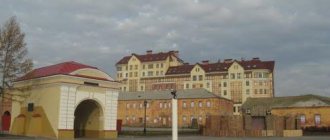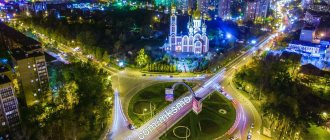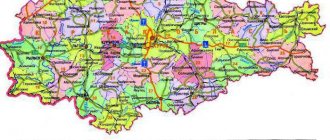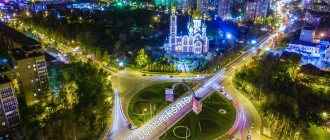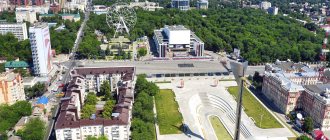Omsk is a city in the south of Western Siberia, the administrative center of the Omsk region. It is located in the valley of the Ob River - one of the largest rivers in Siberia, in the zone of Siberian forest-steppes. The Trans-Siberian Railway passes through the city. Industry is quite developed. At the same time, the city is not very suitable for visiting by vacationers and tourists, including due to the lack of sufficient infrastructure, bright attractions and a small amount of greenery. The Central District is most suitable for visitors. The population of the city is over 1 million people.
Administrative division of Omsk
As part of the administrative division in the city of Omsk, there are only 5 districts (administrative districts), each of which is located within the city. The city of Omsk is a municipal entity with the status of an urban district.
The city districts are as follows:
- Kirovsky. Formed in April 1933. The area of the district is 129 square meters. km. The population is 251 thousand people, which tends to grow.
- October. It was formed in April 1942. The area of the district is 65.7 square meters. km, and the number of inhabitants is 170 thousand people. The population is gradually decreasing.
- Leninist. It was formed in August 1930. The area is 153 sq. km. The number of residents of this area is 200 thousand people. and gradually decreases.
- Soviet. Appeared on the map of Omsk in August 1930. Covers an area of 103 square meters. km. The population is 264 thousand people, and the number of residents is gradually increasing.
- Central. Formed in August 1945. Has an area of 105 square meters. km. The population is 276 thousand people. with negative dynamics.
Most districts are located on the right side of the river, and only the Kirovsky district is located to the left of it.
Map of the Omsk region by district
The territory of the Omsk region is larger in size than many Western European countries. It occupies 139.7 thousand square kilometers, which is one fifth of Western Siberia, and is located in the southern part of the West Siberian Plain.
In the north and west, the Omsk region borders on the Tyumen region, in the east there is a border with the Novosibirsk and Tomsk regions. In the south and southwest it has a border with Kazakhstan. The Omsk region is divided into 424 municipalities: 1 urban district, 32 municipal districts, 26 urban settlements and 365 rural ones. 1.97 million people live in the Omsk region, of which 71.76% live in cities.
Omsk region. Online map (The dotted line indicates the boundaries of the area on the map)
Since the region is located in the northern hemisphere, the climate is harsh. Winter is characterized by low temperatures, with cold snaps occurring in spring and autumn. Temperatures are erratic and fluctuate wildly throughout the year. This is explained by the fact that the flat nature of the region allows air masses to move freely across its territory, both from the south and from the north. Within a few hours, there may be a change from warm weather to a sharp cold snap. The average temperature range from the coldest to the warmest month is 38 degrees. Moreover, over the vast territory of this region between the northern and southern parts, the temperature difference ranges from 1 to 3 degrees. The climate in different parts of the region is varied. The region is not inferior to Ukraine and the North Caucasus in terms of the number of sunny days. On average, the region's territory is arid; in winter the snow cover is small (up to 60 cm).
Districts of the Omsk region:
|
|
Map of the Omsk region by district
Cities and towns:
|
|
The largest cities in the region: Omsk with a population of 1 million 131 thousand people, Tara - 27 thousand people, Isilkul - 26 thousand people, Kalachinsk - 24, Tavrichesky - 14. It is estimated that the total number of rivers in the Omsk region is 4230 km. Among them, there are only 11 rivers with a length of more than 100 km. The powerful Siberian Irtysh River flows through the entire Omsk region; with the help of shipping, numerous economic connections are carried out between neighboring regions and Kazakhstan. Along with a large number of rivers, there are 16,000 large, medium and small lakes. Only 25 of them are large and have an area of more than 10 square meters. km. The region is distinguished by a huge number of swamps with a total area of more than 2000 hectares. The unique character of the nature of the Omsk region lies in the fact that from north to south there is a change in natural complexes: from taiga to steppe plains. There are 13 botanical reserves, 17 zoological reserves, one natural park and 99 natural monuments on the territory. The Bairovsky reserve, for example, is the oldest reserve in the Irtysh region, in which numerous species of birds, including waterfowl, and countless wild animals are preserved in their natural environment. Conditions have been created for the reproduction of beavers and otters. In the Omsk region you can get acquainted with 1,700 historical monuments (mounds, ancient settlements) and interesting modern buildings. Many have heard about Peipus Mountain, Ermak's Pier, Bogatyrsky Mounds, Mount Tara, Chekhov's Import and others. The Vrubel Museum of Fine Arts is widely known in Omsk - one of the largest in Russia. It contains a rare exhibit - Scythian gold. In the floodplain of the Bolshaya River there is the Bolsherechensky Zoo with an area of 19 hectares, which is the northernmost in the world (1,400 species of animals, 160 species of birds, reptiles, etc.). And in the Bird Harbor natural park in the center of Omsk there are 300 species of plants, 160 species of birds and more than 250 species of insects. At Lake Ik you can see the northernmost colony of pelicans. In the area of the village of Okunevo there are the most ancient underground ruins of a huge temple. Tourists are also interested in the Omsk fortress, built in 1716 by Swedish prisoners of war, and the oldest guardhouse building in Omsk with original decor. The first mansion with steam heating, built in 1902 by the merchant Batyushkin, has also been preserved in Omsk. The Museum of History and Local Lore in Omsk was founded in 1878 on the initiative of world-famous travelers and scientists. The exhibition is based on collections from expeditions from China, India, Central Asia, and Siberia. The Dostoevsky Literary Museum is located in the commandant's house. The writer was serving hard labor in Omsk. The atmosphere of the past is recreated by ancient houses and fortress gates to enter the city. 50 km from Omsk there is an ancient women’s Achairsky monastery.
Soviet district
In the past, this area was called the oil town and was built specifically for workers of local oil companies. Later the town became part of Omsk. There is no chaotic or private development here, everything is done as per the drawing, as it was built in Soviet times according to a specific project.
This area is also known as a student town, as there are as many as 5 higher educational institutions here. Therefore, there are a lot of young people on the streets and it is quite noisy. There are also many petroleum engineers living here. And the presence of an oil refinery greatly worsens air quality due to industrial emissions.
Pervomaisky district is sandwiched between the Central and Soviet districts. The environment here is quite bad, which is associated with the work of enterprises.
Is it worth moving to Omsk for permanent residence?
The city of Omsk is located in Western Siberia at a distance of 650 km from Novosibirsk. And there has always been and is competition between these cities - they are often compared in terms of economic development, urbanization, salaries, purchasing power. Immigrants usually have a choice of Omsk or Novosibirsk. By migrants we mean not only residents of the Siberian District, but also citizens of the CIS. Most Russians immigrate from Kazakhstan, going to get higher education or under the resettlement program. This fact has a positive effect on the demography of the Omsk region.
Omsk is the largest city in Russia with an area of 577.9 square meters. km. In 2021, the population was 1.139 million people, which led to 9th place in the ranking of Russian cities.
According to locals, it is worth moving to Omsk for the following reasons:
- Omsk is a historical city that has been intensively put in order. Numerous works are being carried out on the reconstruction and expansion of the Omsk fortress, the House with the Dragon, monuments of wooden architecture, monuments, and Litskevich Square. Already reconstructed - Boulevard named after. Leonid Martynov, pedestrian street named after. Chokana Valikhanova, Theater Square, Academic Drama Theater. The move guarantees a rich cultural life.
- Investment attractiveness. Representatives of local authorities have issued a number of resolutions to support small and medium-sized businesses. The goal is to create favorable conditions and a competitive environment, which, in their opinion, will improve the quality of goods and services, as well as enrich the labor market with vacancies. Any businessman and startuper can contact the municipality for financial, property, image, consulting and information support.
- Beautiful views from the Tukhachevsky embankment at the foot of the Irtysh. This is a developed part of the city with a panorama of the river and including the city of Omsk itself. Omsk residents’ favorite place for walks. Also worth reviewing are the largest Omsk bridges crossing the Irtysh and Om rivers.
- In recent years, many stylish leisure establishments have appeared and I must say this trend is still in force. Here are some places where you can eat deliciously - Manillov Gourmet, Sienkiewicz, Pine Bar, Noodle Cafe, 1984 Brewing Co.
- As part of the “Formation of a Comfortable Urban Environment” program, funds have been allocated for the improvement of the private sector. And work is already in full swing to repair roads, sidewalks, pedestrian paths, and install storm drains. This expands buyers' options for choosing real estate.
So far, Omsk is on the list of the worst cities in Russia in terms of living standards and ecology. This is evidenced by the all-Russian rating, in which the city took 69th place among 75 large constituent entities of the Russian Federation.
Why do people leave Omsk?
In the last ten years, a lot of information has been published about the lack of budget money, which is why the population and business have suffered greatly. So, according to migration statistics, 600 thousand people left during this period. People left in search of a better life in the Tyumen, Krasnodar, Novosibirsk, Leningrad, and Kaliningrad regions.
If you shake everything out of the phrase “in search of a better life,” then residents migrated from their hometown for the following obvious reasons:
- Omsk is dying out - this can be felt in the abandoned and unkempt buildings, as well as in the mood of the population. People complain about employers all the time because of low wages. In 2021, the average income of workers in Omsk was 37 thousand rubles, which is a big minus for a millionaire city.
- Omsk ecology also frightens Omsk residents, who are suffocating from waste from industrial plants and transport emissions. As environmentalists explained, the city was initially developed incorrectly. The largest industrial enterprises are located in urban environments, although according to the rules they must be isolated. Federal highways pass through the city, which also leads to severe environmental pollution.
- The climate forces many people to move to other cities in Russia. Despite the abundance of sunshine, winter in Omsk is harsh. The average temperature in summer is +18 °C, and in winter, on the contrary, -18 °C, can reach – 40 °C.
Today, problems are being systematically resolved; large amounts of money have been allocated for this from the federal budget. The established time frame for program implementation is 2024.
List of the most dangerous areas of Omsk
The criminal situation in Omsk is unfavorable due to certain places with poor transport access and abandoned areas and buildings. There are free colonies near the city, although locals claim that the prisoners do not harm anyone, they are afraid that they will add more time to their sentences. Omsk residents have a lot of conversations on this topic. In their opinion, old and neglected neighborhoods/villages are considered not the best place to live or even walk.
As a result, the list of the most dangerous areas of Omsk included: Morozovka, Chkalovsky, Old Kirovsk, Port Arthur, CHPP-5.
The city often faces stories of destruction and attacks by businessmen who set fire to historic buildings in order to buy a building site. Such incidents are recorded most often in the Central District.
The terrible picture can only be supplemented by an all-Russian rating, because Omsk is among the top 10 dangerous cities in Russia.
